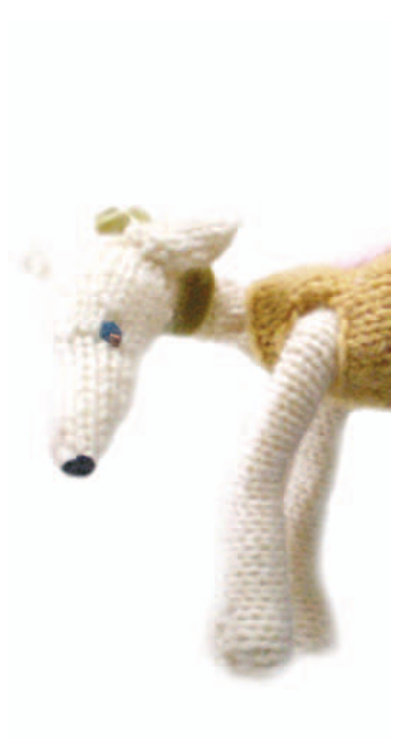
Dot pebbles #freebee pattern page 1 FINISHED SIZE 33cm/ 13in long from heel to neck x 30cm/ 11%in wide, arms outstretched YARN % 50gm ball DK (light-worsted) weight Shown in MC - Rowan Pure Wool DK shade 13 Enamel (MC) NEEDLES set size 3mm (US size 3) double pointed needles TENSION 24 stitches and 35 rows counted over a 10cm/ 4in square working stocking stitch in main colour and using size 3mm (US size 3) double pointed needles NOTIONS small circles felt in eye colour and tiny seed beads for the eyes, black sewing thread and needle, 5 small safety pins for holding stitches, tape measure, toy filling Special instructions and abbreviations can be found at the end of tbe patterns
Greyhound The Princess Snowdrop
Muzzle, head, body & legs make as one piece Beg with the tip of the nose leave a long tail end and cast on 4 sts, using size 3mm (US size 3) needles. 1st row (WS) P. Row 2 (inc) Kfb, k2, kfb. 6sts Row 3 Purl into front then knit into back of st to increase one stitch,
Shape front of head
Row 12 (inc) K4, [kfb] four times, k4. 16sts Row 13 P.
Shape jaw
Row 14 (inc) Kfb, k to last st kfb. 18sts Row 15 (WS) P.
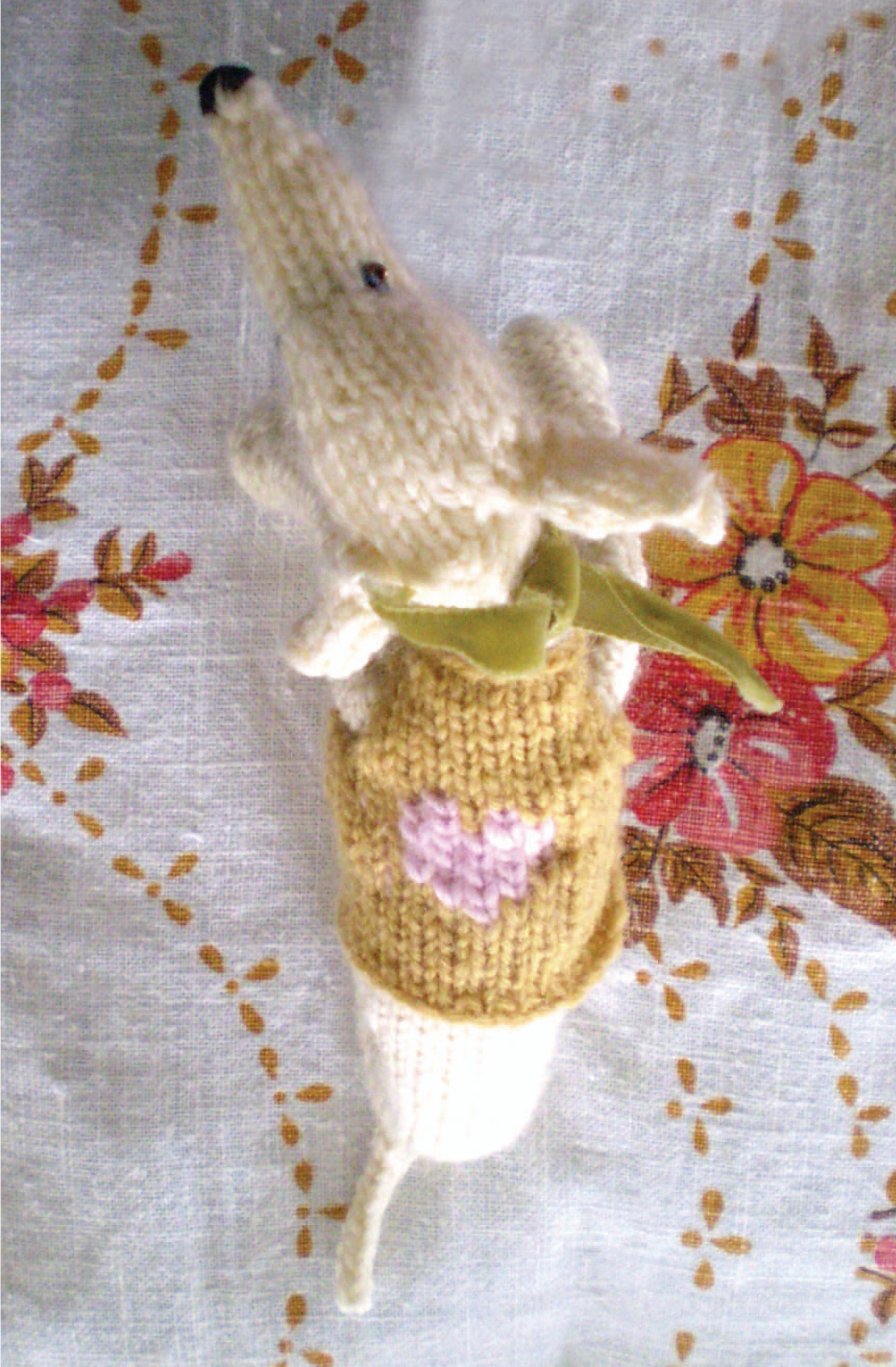
Dot pebbles #freebee pattern page 2 Dot pebbles #freebee pattern page 3
Front legs
Row 42 WS facing, cast on 22 sts at beg of next 2 rows. 53sts Knit and divide all 18 sts 0ver 3 dpns as follows: N1 - k6, n2 - k6, n3 - n6. RS of knitting facing join for working in the round. Keep tension fairly tight in first rnd. Rnd 16 (inc) K9, m1, k9. 19sts
\*Shape feet
Shape back of head
Row 44 (WS) P5, turn. Row 45 Sl1, k3, turn. Row 46 Sl1, p2, turn. Row 47 Sl1, k1, turn. Row 48 Sl1, p to end. Next row K5, turn. Next row Sll, p3, turn. Next row Sl1, k2, turn. Next row Sll, pl, turn. Next row Sl1, k to end. Work 3 rows st st. Rnd 17 (dec) K16, skpo. Turn and work on sts for Head Back as follows: Row 18 (dec) Sl1, p13, p2tog, turn. 17sts Row 19 (dec) Sl1, k11, skpo, turn. 16sts Row 20 (dec) Sl1, p8, p2tog, turn. 15sts Row 21 (dec) Sl1, k4, skpo, turn. 14sts Row 22 (dec) Sl1, p2, p2tog, turn. 13sts Row 23 Sl1, then k8 sts to beg the rnd. Place marker. Join for working in the rnd. Rnd 24 K13. Rep last row once more.
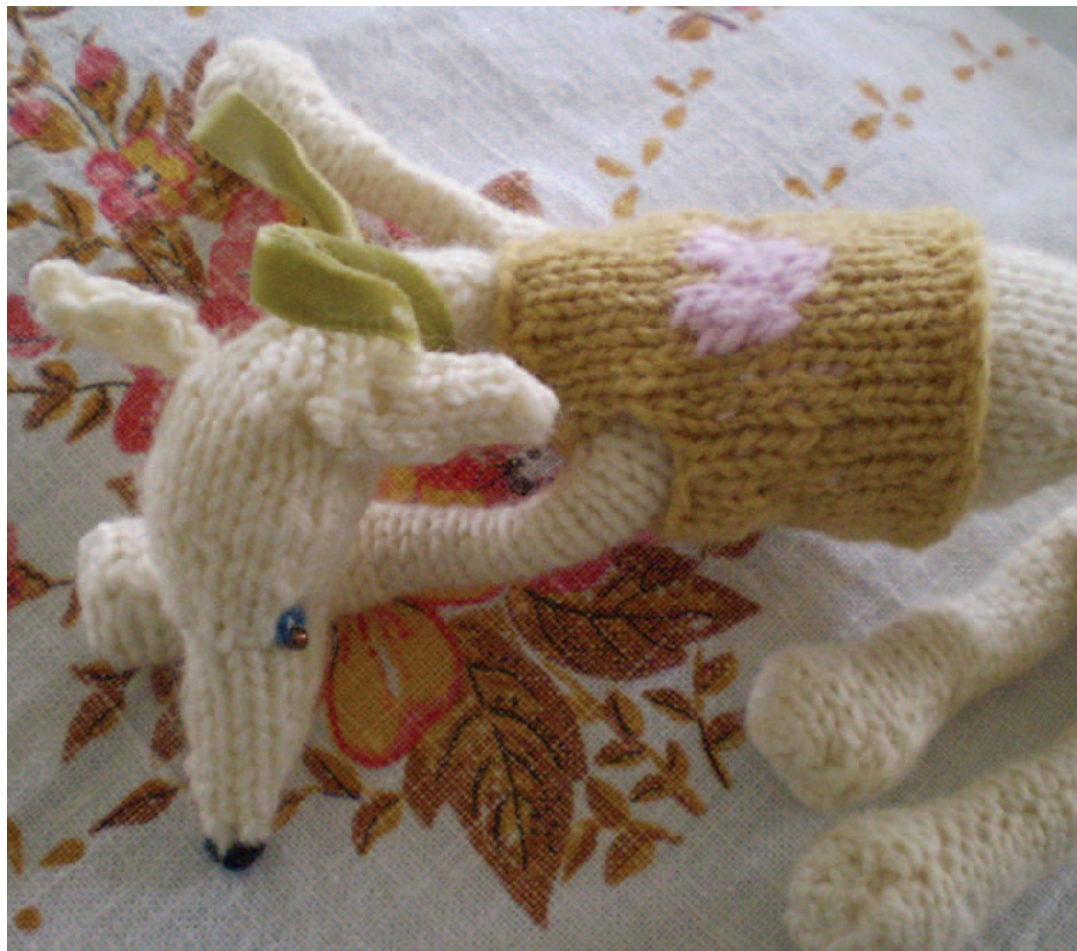
Inside front left leg
shape neck
Working on these last 22 sts for inside left leg, cont in st st for 3 rows.
Shape inside left foot
Rnd 26 Kfb, k4, k3t0g, k4, kfb. Rnd 27 K13. Rep last 2 rows twice more, re-arranging the sts: N1 - 3sts, n2 - 7sts, n3 - 3sts. Rnd 32 (inc) [Kfb] twice, k3, k3tog, k3, [kfb] twice. 15sts Rnd 33 K15. Rnd 34 (inc) [Kfb] twice, k4, k3tog, k4, [kfb] twice. 17sts Rnd 35 K17. Place marker, work 5 rnds st st (every rnd k). Remove marker. Next row (RS) K5, turn. Next row Sl1, p3, turn. Next row Sl1, k2, turn. Next row Sl1, p1, turn. Next row Sl1, k19 to end of Inside Leg. Turn. Bind off 22 sts. Next row WS facing, rejoin yarn to foot end of Right Leg. P22. Turn
Divide for front
Inside front right leg
Work 3 rows st st, so ending with a RS row. Rnd 41 into rnd 42 K4, slip last 8 sts off needles onto a safety pin, k9. Turn. WS facing work back and forth as follows:
Shape inside right foot
Next row P5, turn. .
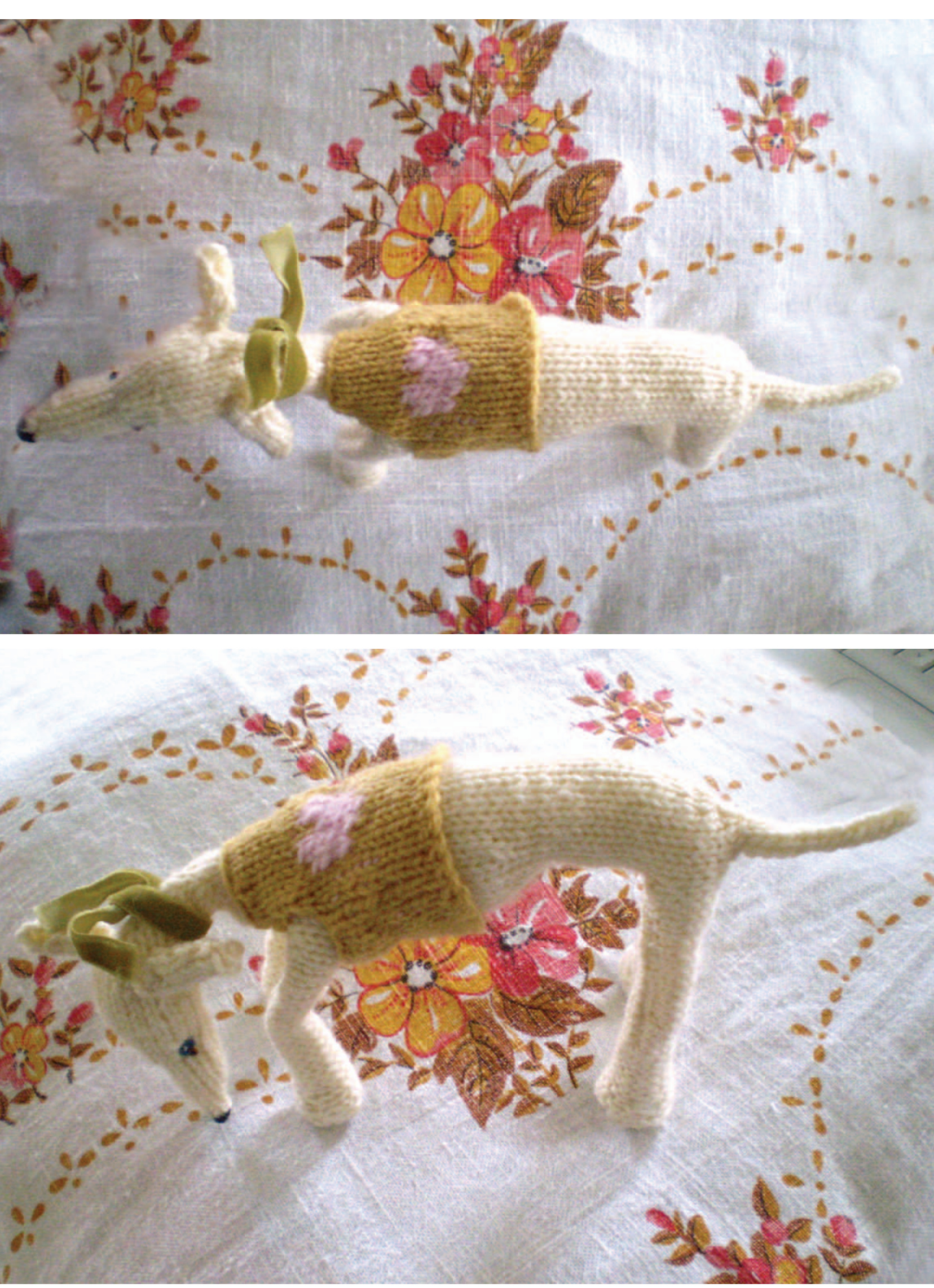
Dot pebbles #freebee pattern page 4 Next row Sl1, k3, turn Next row P5, turn. Next row Sl1, k3, turn. Next row Sl1, p2, turn Next row Sl1, kl, turn. Next row Sl1, p19 to end of Inside Leg, turn. Bind off 22 sts. Leave 9sts from Back onto the needle as you return to Front as follows:
Front
Slip 8 sts at neck off safety pin onto 3mm (US size 3) dpn Row 42 RS facing rejoin yarn. K across. Work 7 rows st st.
Join Front to Back
Row 50 (RS) Divide as follows: N1 - K8sts, n2 - k4sts,, n3 - K5sts. RS of knitting facing, join for working in the rnd Pull tension tight as you k across junctions.
Shape tummy
Rnd 51 (inc) K8, [k2, m1] twice, k1, [m1, k2] twice. 21sts Rnd 52 K21. Rnd 53 (inc) [K2, m1] six times, k2, kfb, k2, (m1, k2) twice, m1. 31sts Rnd 54 K31. Rep last rnd six times more. Rnd 61 (dec) K2t0g, k7, k2tog, k20. 29sts Rnd 62 (dec) K2tog, K5, k2tog, k20. 27sts Rnd 63 (dec) K2, k3tog, k2, k2tog, k2, k2t0g, k8, k2tog, k2, k2tog. 21sts Rnd 64 K21. Rnd 65 (dec) K1, k3 tog, k17. 19sts Rnd 66 K19. Rnd 67 (dec) K3tog, k16. 17sts Dot pebbles #freebee pattern page 5
Rnd 68 K17.
Rep last rnd eight times more.
Divide for back legs and tail
Rnd 77 and into rnd 78 K19, slip last 4 sts onto a small safety pin. Cast on 25 sts, k to end. Cont to work in st st, back and forth as follows: Row 78 (inc) Cast on 25 sts, p to end. 63sts
\*Shape feet
Row79 K5, turn. Row 80 Sl1, p3, turn. Row 81 Sl1, k2, turn. Row 82 Sl1, p1, turn. Row 83 Sl1, k to end. Row 79 P5, turn. Row 80 Sl1, k3, turn. Row 81 Sl1, p2, turn. Row 82 Sl1, k1, turn. Row 83 Sl1, p to end
Back shaping
Next row K30, k3tog, k to end. 61sts
Divide for tail
Next row P28, slip next 5 sts of needle onto a safety pin, cont to purl 28sts beneath the tail to end of row. Keep tension tight to avoid large gaps as you purl above the sts held on the pin. 56sts
Inside back left leg
Next row K25. Turn, working on these last 25 sts for Inside Left Leg, cont in st st for 3 rows.
Shape inside left foot
Next row K5, turn. Dot pebbles #freebee pattern page 6 Next row Sll, p3, turn. Next row Sl1, k2, turn. Next row Sl1, p1, turn. Next row Sl1, k22 to end of inside leg. Turn. Bind off 25 sts. WS facing, rejoin yarn to foot end of Right Leg
Inside back right leg
Next row P25. Turn, working on these last 25 sts for Inside Right Leg, cont in st st for 3 rows.
Shape inside right foot
Next row P5, turn. Next row Sl1, k3, turn Next row Sll, p2, turn. Next row Sl1, k1, turn. Next row Sl1, p22 to end of inside leg. Turn. Bind off 25 sts. RS facing, rejoin yarn to 6 sts at tail end, k2tog, k2, k2tog. 4sts Work stocking st for 5 rows, so ending with a WS row. Cut yarn, leave sts on needle.
Join seam beneath back legs
Slip 4 sts held on safety pin at Under Body onto 3mm (US size 3) dpn. Cut working yarn leaving about 60cm (1ft) tail. Hold needles parallel in left hand as if ready to knit across the row. Work Kitchener Stitch to close seam.
Tail
Slip 5 sts off safety pin at Tail onto a 3mm (US size 3) dpn. K5 work as i cord - sts to other end of dpn without turning, for 7 rnds. Next rnd (dec) K2tog, k1, k2tog. 3sts Dot pebbles #freebee pattern page 7 Cont to work as i cord until entire tail measures approx. 10cm/ 4in. Cut yarn, thread end through last 3 sts. Fasten off, weave in ends.
Ears make 2 alike
Using 3mm (US size 3) needles and yarn MC (main colour), cast on 3 sts leaving a long tail end for sewing Ear to Head. 1st row (WS) P. Row 2 Kfb, k to last st, kfb. 5sts Rep last 2 rows once more. 7sts Row 5 P. Row 6 K2tog, k to last 2 sts, k2tog. 5sts Rep last 2 rows once more. 3sts Row 9 P3tog. 1st Fasten off. Weave in end.
To make up
Carefully turn out to Ws. Backstitch row ends at side of head and along nose. Carefully turn out to Rs. Use your finger to push out the shaping at Nose. Sew on the eyes - the beads onto the felt onto the head. Stuff head and neck fairly firmly. Embroider a black nose, using black thread, at the top of 'nose' shaping. With CO end at ear join to each side of Head at head shaping decreases. WS of Front Leg fold leg in half joining row ends and matching foot shaping. Leave tops (cast off edges) of legs un-sewn, mattress seam rows ends to join inside leg to outer leg, work a running stitch, in and out, around CO at foot, stuff foot quite firmly, pull up tight to gather and secure. Using tweezers, stuff leg at “knee' and ‘thigh' to create the desired leg Dot pebbles #freebee pattern page 8 shape shaping foot as you do so. Join seam around Front Leg, stuff body quite firmly. WS facing, fold Back Leg in half joining row ends, matching foot shaping. Leaving tops (cast off edges) of legs un-sewn, mattress seam rows ends to join inside leg to outer leg, work a running stitch, in and out, around CO at foot, stuff foot quite firmly, pull up tight to gather and secure. Weave tail end through stuffing back inside foot. Using tweezers, stuff leg at “knee' and ‘thigh' to create the desired leg shape shaping foot as you do so. This next bit is a little tricky, try gently pressing the pieces first to stop them from curling: join seam around Back Leg, stuffing back of body, quite firmly, as you do so. If necessary backstitch any gap from under Tail. Take time to really 'sculpt your dog to give him a greyhound body shape.
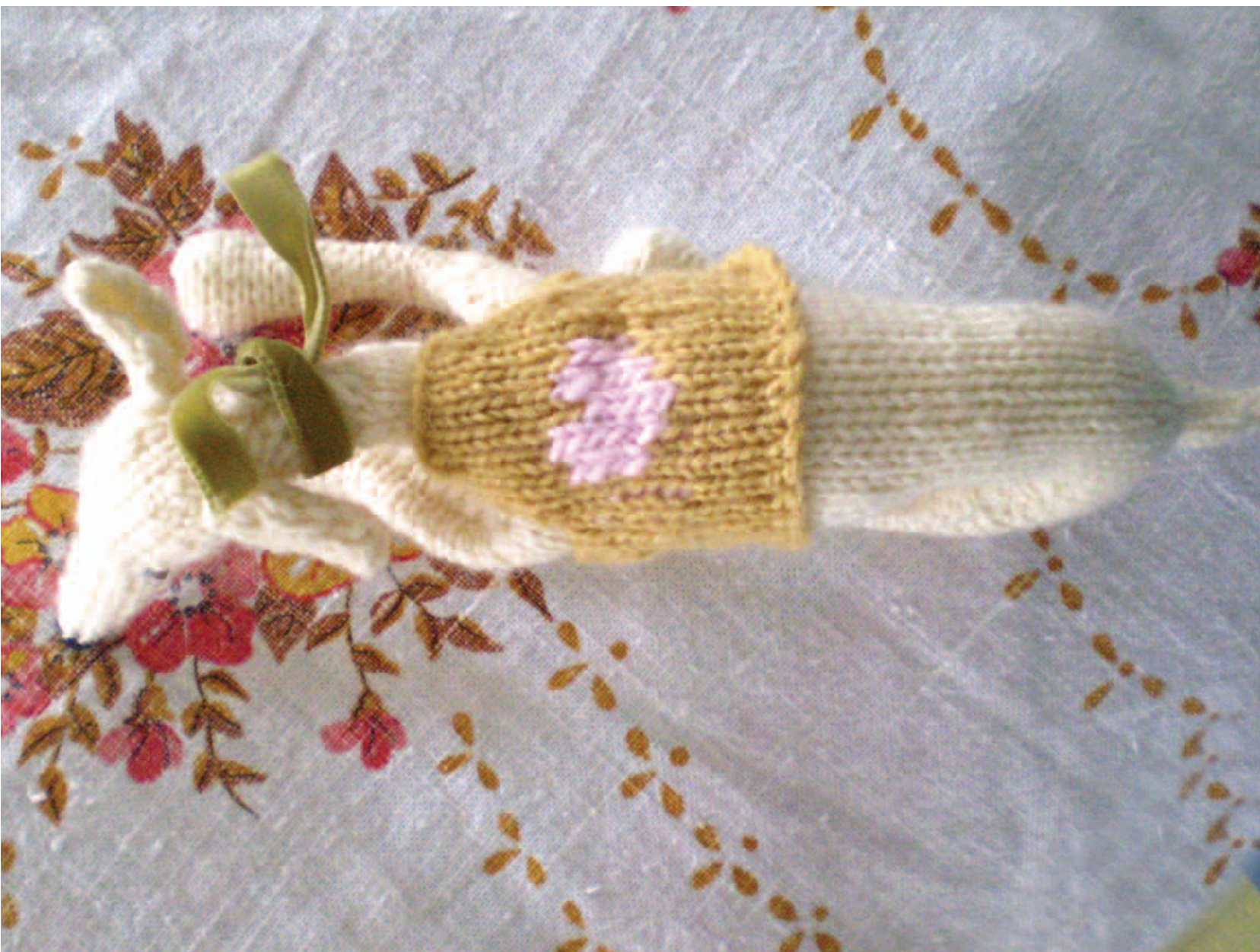
Dot pebbles #freebee pattern page 9 FINISHED SIZE 6%cm/ 2%in long x 14cm/ 5%in waist YARN small amount DK (light-worsted) weight (MC) and heart (H) Shown in MC - Jamieson's DK shade 375 Flax (MC), Rowan Soft Baby shade 033 Sea Pink (H) NEEDLES set size 3mm (US size 3) double pointed needles TENSION 24 stitches and 35 rows counted over a 10cm/ 4in square working stocking stitch in main colour and using size 3mm (US size 3) double pointed needles Special instructions and abbreviations can be found at tbe end of tbe patterns
Sweet heart jacket
Jacket
Using 3mm (US size 3) dpns cast on 25 sts in yarn MC - main colour. 1st row (inc) Kfb, k to last st, kfb. 27sts Row 2 (inc) Purl into front, knit into back of st (pfkb) p to last st, pfkb. 29sts Work 2 rows st st. Knit to divide all 29 sts 0ver 3 dpns as follows: N1 - K10, n2 - k9, n3 - k10. RS of knitting facing join for working in the rnd. Rnd 6 K29.
Add heart motif
Join in heart colour (H) and strand across the back of the jacket until needed as follows: Rnd 7 (MC) K14, (H) k1, (MC) k14. Rnd 8 (MC) K13, (H) k3, (MC) k13. Rnd 9 (MC) K12, (H) k5, (MC) k12. Rep last rnd twice more. Rnd 12 (MC) K12, (H) k2, (MC) k1,(H) k2, (MC) k12. Rnd 13 (MC) K13, (H) k1, (MC), k1, (H) k1, (MC), k13. Cut yarn H. Dot pebbles #freebee pattern page 10
Armholes
Rnd 14 (dec) K3, bind off next 6 sts, k10, bind off next 6 sts, k2. 17sts Rnd 15 K next 3 sts so that 6 sts are on one needle - 3sts just knitted plus 3sts from last rnd - turn and work back & forth on these 6 sts for underside of jacket. Rnd 16 P. Work 2 rows st st. Cut yarn, leave sts on needle. Rnd 19 RS facing, rejoin yarn to 111sts from top of jacket. Skpo, k7, k2tog. 9sts Work 3 rows st st.
Join top to bottom
Rnd 23 K9 from Top, then from 6 sts at Bottom - k2tog, k2, k2tog. 13sts. Keep tension tight as you knit across the tops of the sleeves. Rnd 24 K13. Rep last rnd three times more. Bind off. Weave in all ends, neatening around the armholes.
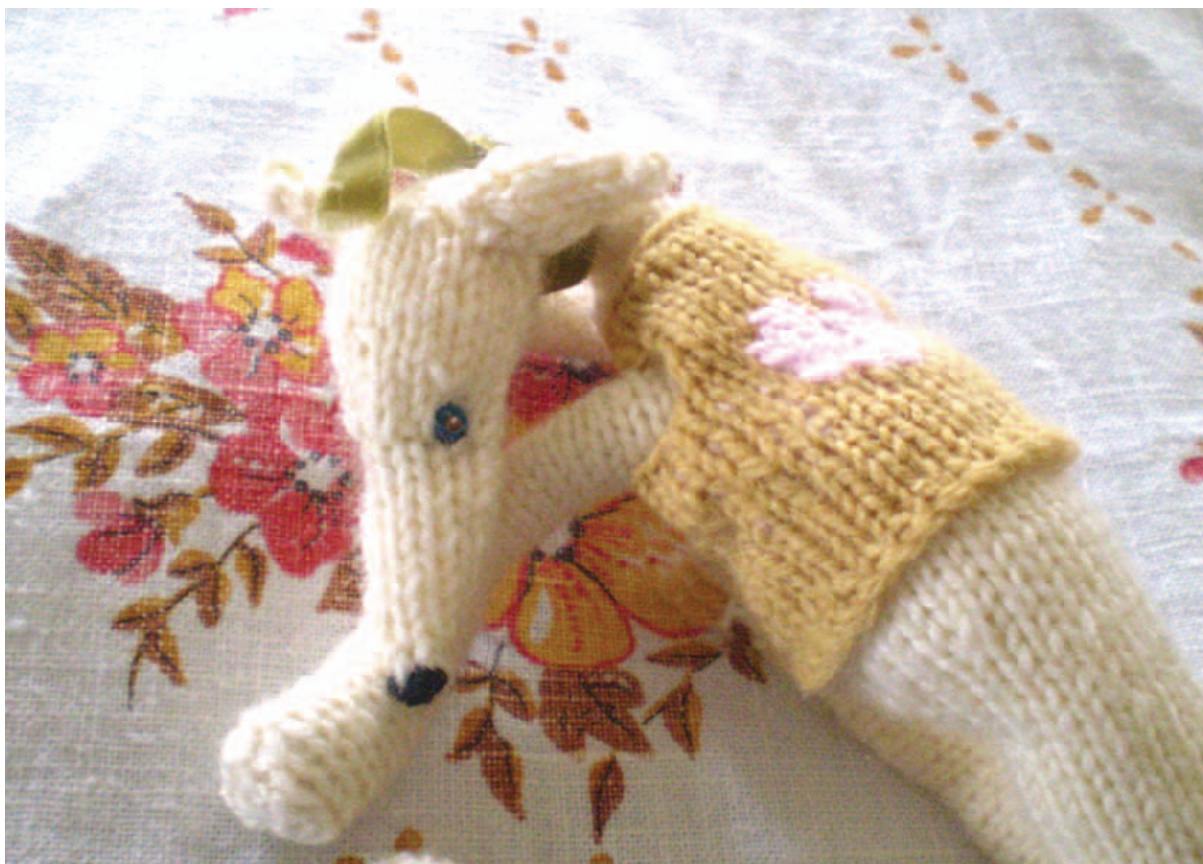
Knitting etc. knowledge
abbreviations
cm centimetre/ s lh left hand rem remaining CO cast on m1 make a stitch (see definitions) rh right hand cont continue mc main colour rs right side dec decrease mm millimetre skpo or psso slip, knit pass over DK double knit Ppurl (see definitions) ft foot/ feet as in measurements patt pattern sl slip gm gram/ mes pfkb purl into front, knit into back st/sts stitch/es in inch/es pup&k pick up and knit tbl through back loop inc increase (see definitions) WS wrong side kknit/ knitting re regarding yf Bring yarn to front of work kfb knit into front, then back rep repeat yo yarn over (see definitions)
definitions
The following definitions are brief explanations of tbe special tecbniques and some of tbe basic tecbniques tbat may bave been used within tbese patterns. Some definitions are explained witbin tbe patterns tbemselves, especially if tbey occur regularly and areuncommon,someareillustratedwbereitiseasiertosbowa diagram than it is to put into words. Plus for extra tuition, sometimes with step-by-step video footage, tbe Internet provides wonderfultutorials onall these and otberspecialorbasic tecbniques
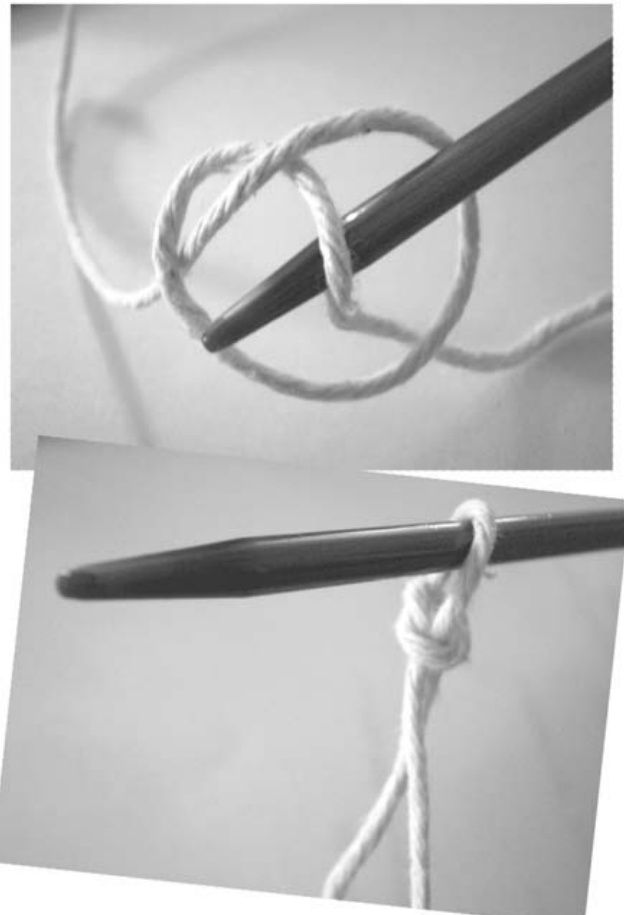
Slip knot this is generally how to begin knitting or crochet and usually becomes the first stitch; it is the beginning of the cast on method adopted for these patterns and it is also how to begin a crochet chain. To make a slip knot work the yarn, with your fingers, into a half knot but don't pull the knot closed - this will leave you with a loop. Slip the point of the knitting needle, or crochet hook for crochet projects, under the loop then pull the working yarn, this is attached to the yarn ball, gently until the knot lies, not too tightly, onto the needle or hook. Cast on placing stitches on the needle to begin knitting. There are many ways to cast on although (unless stated otherwise within the pattern) the Knitting-on method is the type I have adopted throughout all of my patterns. Leaving about a 20cm/ 8in tail end, make a slip knot. Place the slip knot onto the tip of one of the needles, Fig 1 - the yarn from the ball (the working yarn) should be ready to work on the right of the knot. Begin adding stitches to the needle by taking the needle with the slip knot in your left hand. With the other needle in your right hand, \*push the tip of the right-hand needle into the slip knot loop (1st stitch) from the front to the back of the loop and under the left-hand needle. Now wrap the working yarn around the tip of the right-hand needle, over from front to back. Fig 2. Slide the tip of the right-hand needle down to catch this new loop of yarn. Fig 3. Lif the loop up and place it onto the left-hand needle. Fig 4. Repeat from \* to \*\* until you have cast on the number of stitches needed.
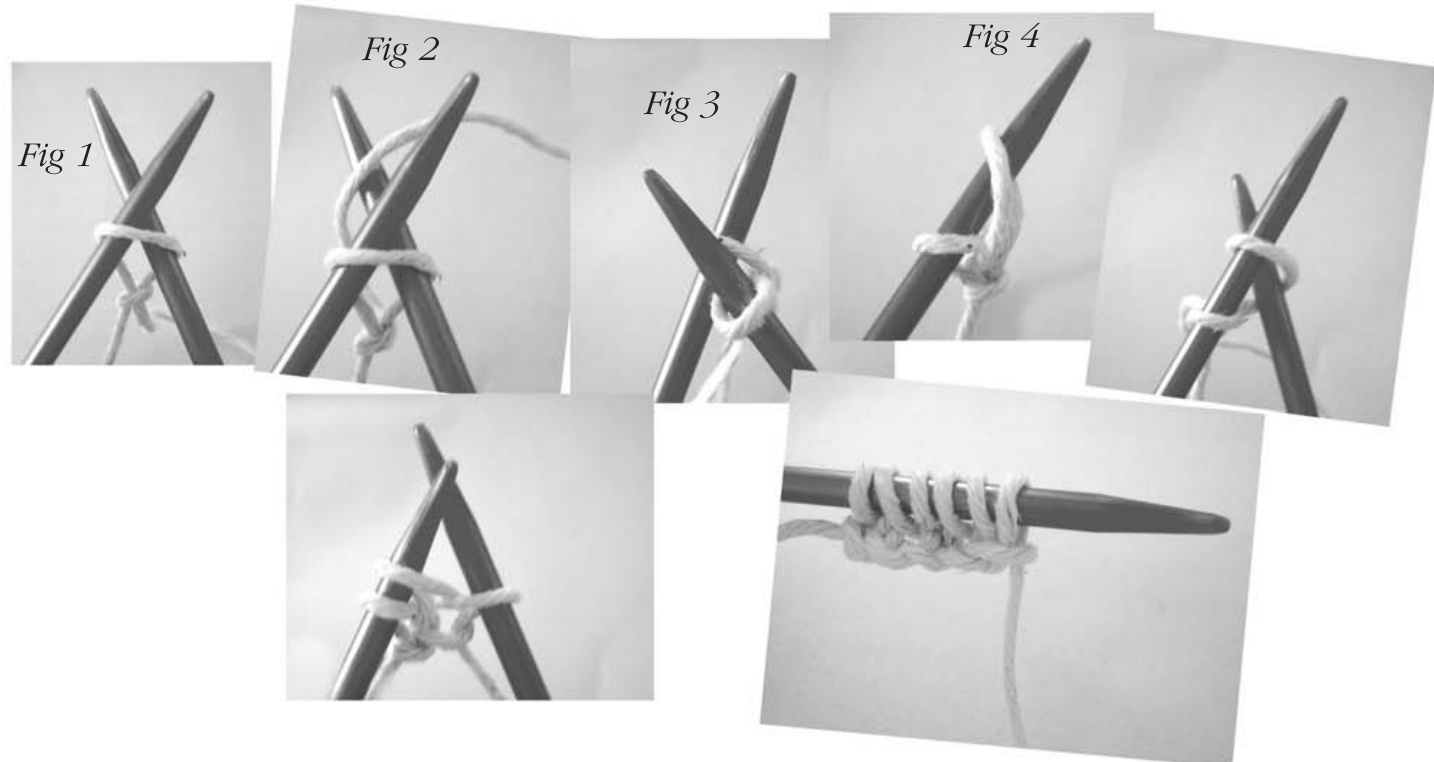
Backward loop cast on (bl) the only other alternative cast on method that is mentioned in any of my patterns and it is because it is the best cast-on method when adding stitches in the middle of a row, even though to work the next row over the new stitches can need a lile patience! Basically you twist a loop of yarn around your forefinger then slip this new loop onto the right-hand needle to increase a stitch. Hold the working yarn in your left hand with the needle in your right. Extend your left forefinger parallel to the yarn, dip your finger under the yarn and towards you, you should have a single loop of yarn around your finger. Move the tip of the right-hand needle from the base of your finger so that the needle is through the loop on your finger. Remove your finger, tighten the loop on the needle. Brackets when you come across these brackets [] in a pattern enclosing an instruction/ number and followed by a number, work the instruction within the bracket the number of times stated. For example: [K5, k2 tog] 5 times means knit 5 sts then knit 2 stitches together - do these two instructions five times When you come across this bracket () in a pattern enclosing an instruction/ number it is there for your information only: (25 sts) means there are 25 stitches on the needle and usually appears at the end of a row when there has been an increase or decrease. Or (right arm) tells you where about you are within the pattern. Knit one of the two most basic stitches in knitting. There are other methods - this is the one I adopt: Hold the full needle (the needle with all the stitches on) in your left hand and the empty needle in you right. Insert the tip of the needle in your right hand into the first stitch from left to right, front to back. Wrap the working yarn around the back needle (right-hand needle) counter clockwise. Draw the loop through the stitch at the front of the work - this is the new stitch. Now slide the old stitch from the left needle. Purl the second of the two basic stitches. This is the reverse of a knitted’ stitch and loops like a horizontal bar. To work a purl stitch, insert the needle from right to left in front of the work with the yarn at the front. Wrap the yarn around the right-hand needle in front of the work counter clockwise as you did for knit'. Draw the loop through the stitch, slide the old stitch off the needle. French knot working this embroidery stitch embellishes the knitting with texture and fine detail, a French knot is also useful useful for creating the pupil and highlight for the doll's eye. Thread up a sewing needle with cotton thread or light-weight yarn. With the thread secured at the back of the work, bring the threaded needle through from the back of the work to the front where you want the knot to be. Wrap the yarn around the needle clockwise, three times. Holding the loops in a tight bundle with your thumb and forefinger, pull the needle through the coils by inserting the needle back into the fabric near the base of the knot, not in the same place. Secure the thread at the back of the work. i cord - an i cord, as the name suggests, is a cord or tube like a thick knitted string. Using 2 double pointed needles (dpns) cast on the number of stitches as directed within the pattern and knit across them. Then, instead of turning your knitting as you normally would, slide the stitches to the opposite end of the needle with the same side of the work still facing you. The working yarn will be at the wrong side of the work. Keeping the working yarn at the back, knit across the stitches. Slide the stitches to the opposite end of the needle again, with the working yarn at the back, knit across the stitches, drawing the knitting into a tube made of garter stitches. Pull the yarn quite tightly when knitting the first stitch. To reiterate - the working yarn is always on the wrong side of the cord, the right side of the wrong is always facing you. Kitchener stitch or grafting: to 'graft' or sew together live' stitches held on double pointed needles (dpns) that are held parallel in your left hand. Thread up a yarn needle with the tail end, insert the threaded needle purl-wise into the first stitch on the double pointed needl (dpn) closest to you, pull the yarn through, leave the stitch on the needle. Insert the threaded needle into the first stitch on the back dpn, as if to knit, pull yarn through, leave that stitch on the dpn. \*Insert the threaded needle into the same front stitch, this time knit-wise, then slip that stitch off the dpn then bring threaded needle through the next front stitch as if to purl it - leave this stitch on the dpn. Pass the threaded needle through the same stitch on back dpn - this time purl-wise, slip that stitch off the dpn, then bring threaded needle through the next back stitch as if to knit it - leave this stitch on the needle.\*\* Repeat from \* to \*\* until there is one stitch remaining. Fasten off the last remaining stitch. K2 tog knit 2 sts together. As knitting - insert the tip of the needle in your right hand, this time into the next two stitches on the left needle from left to right, front to back. Wrap the working yarn around the back needle (right-hand needle) counter clockwise. Draw the loop through both stitches at the front of the work - leaving one stitch remaining. Now slide this stitch from the left needle. One stitch decreased. Knitting in the round (rnd) is a process of working seamless knitting, that is not having to sew a seam to join front to back for example. It is working knitting around and around without having a beginning or an end - the start of the piece is however marked by a stitch marker of knotted loop of spare yarn. And it is worked, in the case of these patterns, with four double pointed needles (dpns). To join for working in the round' begin with two of the double pointed needles and cast on stitches in the normal way, then spread the stitches as evenly as numbers will allow dividing them over three of the needles. Fig 1 Arrange the stitches so that the loops are lined up on the top of each dpn, the working section/ cast on edge of the knitting lying beneath the needles and the working yarn to your right, ready to begin to knit - the three rows of cast on stitches are not to be twisted in a spiral around the needles as you link the last cast on stitch with the first cast on stich by, using your forth needle, knitting into it. Fig 2 then Fig 3 Placing a marker before you knit the first stitch to link/ join the 'round’ determines the beginning of the round. Subsequent rounds are worked from the first stitch after the marker up to the last stitch before the marker. This marker you slip onto the right-hand needle before beginning another round. At the end of each rnd you should have the same number of stitches on each needle that you started with. With the first couple of rounds check to see that the stitches are not twisting/ spiralling around the needles, after that you can be reassured that this will not happen. Note: when you are working in the round you never see the wrong side of the fabric so to make stocking stitch, all rounds are worked all knit (no purling), garter stitch is one round knit, next round purl.
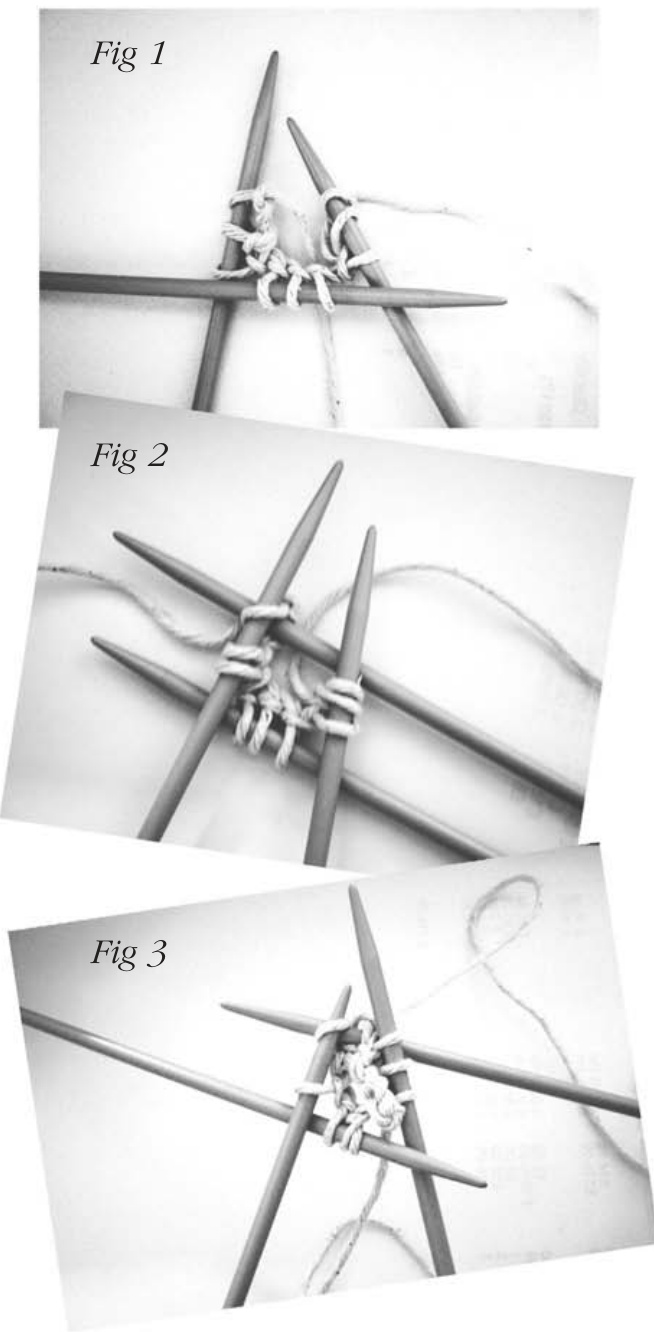
M1 an increase stitch, used primarily a within a row. Knit to where the increase is to occur, in a pattern this will read as k5, m1 - for example, so knit 5 sts, slip the right-hand needle front to back, under the horizontal bar that lies before the next stitch, slip left-hand needle through, from front to back, the picked up bar and allow the stitch to remain on the left-hand needle then, with the right-hand needle, knit into the back of the newly made loop to complete the new stitch. carry on knitting along the row or round unless otherwise stated. Mattress seam is the seam that gives you a non bulky join - perfect for smallitems like dolls clothes. Always use a blunt ended, large eyed, yarn needle (so not to split the stitches) and matching yarn when sewing up your work. Lay the pieces to be sewn up side by side, matching row end stitches or cast on/ cast off stitches. ... Wben joining a vertical/ side seam - insert the threaded up yarn needle in between the first and second stitches on the lower edge of one of the pieces to be joined. With your needle, pick up the first horizontal bar, that look like a ladder rung, and pull the yarn through. Go to the other piece and pick up the adjacent ladder rung/ horizontal bar. Continue picking up the horizontal bars along the edges of the two sides going back and forth from piece to piece, as the sides are joined. ... Wben sewing up borizontal/ cast on and or cast off edges - insert the threaded up yarn needle just inside the cast on or cast off edge of one of the pieces to be joined. With your needle, pick up the two strands that make the V shape of a knitted stitch - at the bottom of the V not the top, pull the yarn through. Go to the other piece and pick up the corresponding V stitch. Continue picking up the V shaped stitches along the edges of the two sides going back and forth from piece to piece. Pick up and knit (pup&k) When the need arises to join a finished row or cast on or cast off edges with new stitches, for example to create the gusset of a sock or edge of a shoe or neckline/ collar to an item of clothing, you work ‘pick up and knit'. With the right side of the work facing and one needle in the right hand, \*insert the needle tip through the knitted fabric to the back, at least two strands from the edge. Wrap counter clockwise, as if to knit, the working yarn around the needle and draw this loop through the fabric to the right side/ front of the work, leave this loop/ new stitch on the needle\*\* - one stitch picked up. Continue from \* to \*\* working along the finished edge picking up more stitches. The pattern will direct you how many stitches are to be picked up'. P2 tog purl 2 sts together. As purling - insert the needle from right to left in front of the work this time into the next two stitches with the yarn at the front. Wrap the yarn around the right-hand needle in front of the work counter clockwise as you did for 'purl Draw the loop through the two stitches, then slide the remaining stitch off the needle. One stitch decreased. Skpo slip stitch, knit a stitch then pass the slipped stitch over - a simple decrease sometimes used with K2 tog to give an even and balanced decrease at the ends or within a row. Simply work up to where the decrease is to be, for example: K5, skpo, k3 - knit 5 sts, slip the next stitch by inserting the right needle into the stitch as if to knit and moving it over to the right needle without winding the working yarn around it, knit the next stitch (a), then with the left needle, pick up the slipped stitch from the right needle and pass it over the knitted stitch (a) and off the needle to lose' a stitch. One stitch decreased. Straight stitches are worked with a sewing or yarn needle. Simply take the threaded needle, secured on the wrong side, from the back to the front of the fabric, work even or random small or medium straight line stitches in the direction shown either from a template or referring to photographs. Yo yarn over - to work this simple increase - usually within a lace pattern - wind the yarn once over the needle from the back then over, from right to left, the right-hand needle, knit the next stitch. Remember, when working the next row or round to work this new 'yarn over stitch' too. Printer friendly versions, pages 19 - 28, follow:
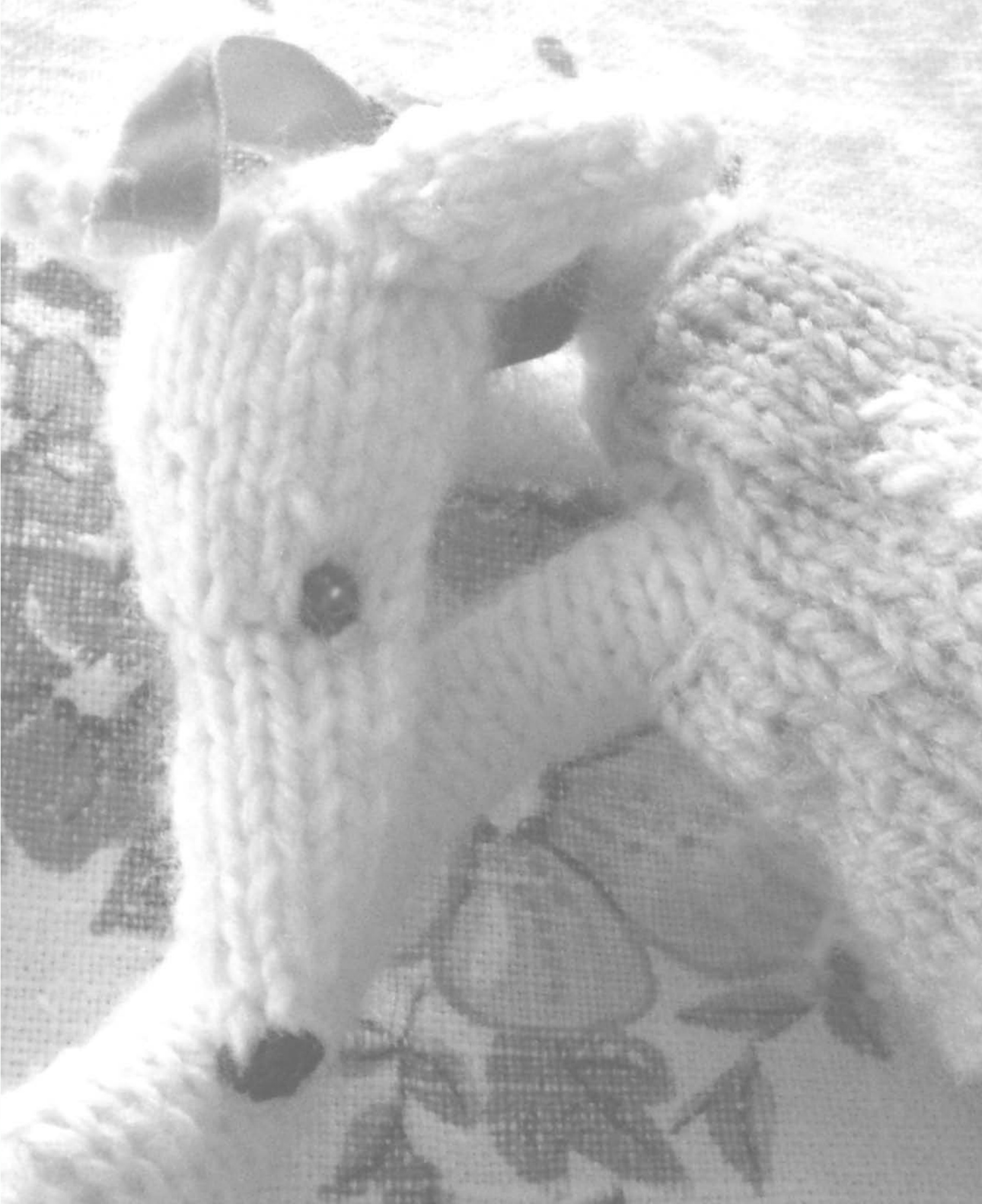
Dot pebbles #freebee pattern page 1 FINISHED SIZE 33cm/ 13in long from heel to neck x 30cm/ 11%in wide arms outstretched YARN % 50gm ball DK (light-worsted) weight Shown in MC - Rowan Pure Wool DK shade 13 Enamel (MC) NEEDLES set size 3mm (US size 3) double pointed needles TENSION 24 stitches and 35 rows counted over a 10cm/ 4in square working stocking stitch in main colour and using size 3mm (US size 3) double pointed needles NOTIONS small circles felt in eye colour and tiny seed beads for the eyes, black sewing thread and needle, 5 small safety pins for holding stitches, tape measure, toy filling Special instructions and abbreviations can be found at the end of tbe patterns
Greyhound The Princess Snowdrop
Muzzle, head, body & legs make as one piece
Beg with the tip of the nose leave a long tail end and cast on 4 sts, using size 3mm (US size 3) needles. 1st row (wS) P. Row 2 (inc) Kfb, k2, kfb. 6sts Row 3 Purl into front then knit into back of st to increase one stitch, (pfkb), p to last st, pfkb. 8sts Rep last 2 rows once more. 12sts Work 6 rows st st, ending with a WS row.
shape front of head
Row 12 (inc) K4, [kfb] four times, k4. 16sts Row 13 P.
shape jaw
Row 14 (inc) Kfb, k to last st kfb. 18sts Row 15 (WS) P. Dot pebbles #freebee pattern page 2 Knit and divide all 18 sts over 3 dpns as follows: N1 - k6, n2 - k6, n3 - n6. RS of knitting facing join for working in the round. Keep tension fairly tight in first rnd. Rnd 16 (inc) K9, m1, k9. 19sts
Shape back of head
Rnd 17 (dec) K16, skpo. Turn and work on sts for Head Back as follows: Row 18 (dec) Sl1, p13, p2tog, turn. 17sts Row 19 (dec) Sl1, k11, skpo, turn. 16sts Row 20 (dec) Sl1, p8, p2tog, turn. 15sts Row 21 (dec) Sl1, k4, skpo, turn. 14sts Row 22 (dec) Sl1, p2, p2tog, turn. 13sts Row 23 Sl1, then k8 sts to beg the rnd. Place marker. Join for working in the rnd. Rnd 24 K13. Rep last row once more.
shape neck
Rnd 26 Kfb, k4, k3t0g, k4, kfb. Rnd 27 K13. Rep last 2 rows twice more, re-arranging the sts: N1 - 3sts, n2 - 7sts, n3 - 3sts. Rnd 32 (inc) [Kfb] twice, k3, k3tog, k3, [kfb] twice. 15sts Rnd 33 K15. Rnd 34 (inc) [Kfb] twice, k4, k3tog, k4, [kfb] twice. 17sts Rnd 35 K17. Place marker, work 5 rnds st st (every rnd k). Remove marker.
Divide for front
Rnd 41 into rnd 42 K4, slip last 8 sts off needles onto a safety pin, k9. Turn. WS facing work back and forth as follows: Dot pebbles #freebee pattern page 3
Front legs
Row 42 WS facing, cast on 22 sts at beg of next 2 rows. 53sts
\*Shape feet
Row 44 (WS) P5, turn. Row 45 Sl1, k3, turn. Row 46 Sl1, p2, turn. Row 47 Sl1, k1, turn. Row 48 Sl1, p to end. Next row K5, turn. Next row Sll, p3, turn. Next row Sl1, k2, turn. Next row Sll, pl, turn. Next row Sl1, k to end. Work 3 rows st st.
Inside front left leg
Shape inside left foot
Dot pebbles #freebee pattern page 4 Next row Sl1, k3, turn Next row P5, turn. Next row Sl1, k3, turn. Next row Sll, p2, turn. Next row Sl1, kl, turn. Next row Sl1, p19 to end of Inside Leg, turn. Bind off 22 sts. Leave 9sts from Back onto the needle as you return to Front as follows
Front
Slip 8 sts at neck off safety pin onto 3mm (US size 3) dpns. Row 42 RS facing rejoin yarn. K across. Work 7 rows st st.
Join Front to Back
Row 50 (RS) Divide as follows: N1 - K8sts, n2 - k4sts, n3 - K5sts. RS of knitting facing, join for working in the rnd Pull tension tight as you k across junctions.
shape tummy
Rnd 51 (inc) K8, [k2, m1] twice, k1, [m1, k2] twice. 21sts Rnd 52 K21. Rnd 53 (inc) [K2, m1] six times, k2, kfb, k2, (m1, k2) twice, m1. 31sts Rnd 54 K31. Rep last rnd six times more. Rnd 61 (dec) K2tog, k7, k2tog, k20. 29sts Rnd 62 (dec) K2tog, K5, k2tog, k20. 27sts Rnd 63 (dec) K2, k3tog, k2, k2tog, k2, k2tog, k8, k2tog, k2, k2tog. 21sts Rnd 64 K21. Rnd 65 (dec) K1, k3 t0g, k17. 19sts Rnd 66 K19. Rnd 67 (dec) K3t0g, k16. 17sts Next row WS facing, rejoin yarn to foot end of Right Leg. P22. Turn
Inside front right leg
Work 3 rows st st, so ending with a RS row.
Shape inside right foot
Next row P5, turn. . 5Dot pebbles #freebee pattern page 5
Rnd 68 K17.
Rep last rnd eight times more.
Divide for back legs and tail
Rnd 77 and into rnd 78 K19, slip last 4 sts onto a small safety pin. Cast on 25 sts, k to end. Cont to work in st st, back and forth as follows: Row 78 (inc) Cast on 25 sts, p to end. 63sts
\*Shape feet
Row79 K5, turn. Row 80 Sl1, p3, turn. Row 81 Sl1, k2, turn. Row 82 Sl1, p1, turn. Row 83 Sl1, k to end. Row 79 P5, turn. Row 80 Sl1, k3, turn. Row 81 Sl1, p2, turn. Row 82 Sl1, k1, turn. Row 83 Sl1, p to end
Back shaping
Next row K30, k3tog, k to end. 61sts
Divide for tail
Next row P28, slip next 5 sts of needle onto a safety pin, cont to purl 28sts beneath the tail to end of row. Keep tension tight to avoid large gaps as you purl above the sts held on the pin. 56sts
Inside back left leg
Next row K25. Turn, working On these last 25 sts for Inside Left Leg, cont in st st for 3 rows.
Shape inside left foot
Next row K5, turn. Dot pebbles #freebee pattern page 6 Next row Sl1, p3, turn. Next row Sl1, k2, turn. Next row Sl1, p1, turn. Next row Sl1, k22 to end of inside leg. Turn. Bind off 25 sts. WS facing, rejoin yarn to foot end of Right Leg
Inside back right leg
Next row P25. Turn, working on these last 25 sts for Inside Right Leg, cont in st st for 3 rows.
Shape inside right foot
Next row P5, turn. Next row Sl1, k3, turn. Next row Sll, p2, turn. Next row Sl1, k1, turn. Next row Sl1, p22 to end of inside leg. Turn. Bind off 25 sts. RS facing, rejoin yarn to 6 sts at tail end, k2tog, k2, k2tog. 4sts Work stocking st for 5 rows, so ending with a WS row. Cut yarn, leave sts on needle.
Join seam beneath back legs
Slip 4 sts held on safety pin at Under Body onto 3mm (US size 3) dpn. Cut working yarn leaving about 60cm (1ft) tail. Hold needles parallel in left hand as if ready to knit across the row. Work Kitchener Stitch to close seam.
Tail
Slip 5 sts off safety pin at Tail onto a 3mm (US size 3) dpn. K5 work as i cord - sts to other end of dpn without turning, for 7 rnds. Next rnd (dec) K2tog, k1, k2tog. 3sts Dot pebbles #freebee pattern page 7 Cont to work as i cord until entire tail measures approx. 10cm/ 4in Cut yarn, thread end through last 3 sts. Fasten off, weave in ends.
Ears make 2 alike
Using 3mm (US size 3) needles and yarn MC (main colour), cast on 3 sts, leaving a long tail end for sewing Ear to Head. 1st row (WS) P. Row 2 Kfb, k to last st, kfb. 5sts Rep last 2 rows once more. 7sts Row 5 P. Row 6 K2tog, k to last 2 sts, k2tog. 5sts Rep last 2 rows once more. 3sts Row 9 P3tog. 1st Fasten off. Weave in end.
To make up
Carefully turn out to Ws. Backstitch row ends at side of head and along nose. Carefully turn out to RS. Use your finger to push out the shaping at Nose. Sew on the eyes - the beads onto the felt onto the head. Stuff head and neck fairly firmly. Embroider a black nose, using black thread, at the top of 'nose' shaping With CO end at ear join to each side of Head at head shaping decreases WS of Front Leg fold leg in half joining row ends and matching foot shaping. Leave tops (cast off edges) of legs un-sewn, mattress seam rows ends to join inside leg to outer leg, work a running stitch, in and out, around CO at foot, stuff foot quite firmly, pull up tight to gather and secure. Using tweezers, stuff leg at “knee' and ‘thigh' to create the desired leg shape shaping foot as you do so. Join seam around Front Leg, stuff body quite firmly. WS facing, fold Back Leg in half joining row ends, matching foot shaping. Leaving tops (cast off edges) of legs un-sewn, mattress seam rows ends to join inside leg to outer leg, work a running stitch, in and out, around CO at foot, stuff foot quite firmly, pull up tight to gather and secure. Weave tail end through stuffing back inside foot. Using tweezers, stuff leg at knee' and ‘thigh' to create the desired leg shape shaping foot as you do so. This next bit is a little tricky, try gently pressing the pieces first to stop them from curling: join seam around Back Leg, stuffing back of body, quite firmly, as you do so. If necessary backstitch any gap from under Tail. Take time to really 'sculpt' your dog to give him a greyhound body shape. Dot pebbles #freebee pattern page 9 FINISHED SIZE 6%cm/ 2%in long x 14cm/ 5%in waist YARN small amount DK (light-worsted) weight (MC) and heart (H) Shown in MC - Jamieson's DK shade 375 Flax (MC), Rowan Soft Baby shade 033 Sea Pink (H) NEEDLES set size 3mm (US size 3) double pointed needles TENSION 24 stitches and 35 rows counted over a 10cm/ 4in square working stocking stitch in main colour and using size 3mm (US size 3) double pointed needles Special instructions and abbreviations can be found at the end of tbe patterns
Sweet heart jacket
Jacket
Using 3mm (US size 3) dpns cast on 25 sts in yarn MC - main colour. 1st row (inc) Kfb, k to last st, kfb. 27sts Row 2 (inc) Purl into front, knit into back of st (pfkb) p to last st, pfkb. 29sts Work 2 rows st st. Knit to divide all 29 sts 0ver 3 dpns as follows: N1 - K10, n2 - k9, n3 - k10. RS of knitting facing join for working in the rnd. Rnd 6 K29.
Add heart motif
Join in heart colour (H) and strand across the back of the jacket until needed as follows: Rnd 7 (MC) K14, (H) k1, (MC) k14. Rnd 8 (MC) K13, (H) k3, (MC) k13. Rnd 9 (MC) K12, (H) k5, (MC) k12. Rep last rnd twice more. Rnd 10 (MC) K12, (H) k2, (MC) k1, (H) k2, (MC) k12. Rnd 11 (MC) K13, (H) k1, (MC), k1, (H) k1, (MC), k13. Cut yarn H. Dot pebbles #freebee pattern page 10
Armholes
Rnd 14 (dec) K3, bind off next 6 sts, k10, bind off next 6 sts, k2. 17sts Rnd 14 K next 3 sts so that 6 sts are on one needle, turn and work back and forth on these 6 sts for underside of jacket. Rnd 14 P. Work 2 rows st st. Cut yarn, leave sts on needle. Work 3 rows st st.
Join top to bottom
Rnd 14 K11 from Top, from 6 sts at Bottom k2tog, k2, k2tog. 15sts. Join in rnd. Keep tension tight as you knit across the tops of the sleeves. Rnd 14 K15. Rep last rnd three times more. Bind off. Weave in all ends, neatening around the armholes.









